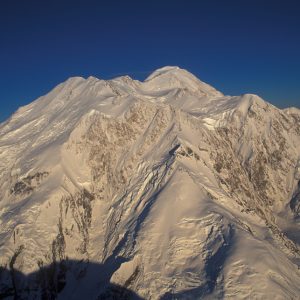Climb Denali! (20,310′)
We have learned a thing or two about taking care of our climbers over the years. This is reflected in our ability to attract and retain the most experienced Denali guides on the mountain, as well as in the extremely positive feedback we receive from our clients. Denali expeditions have been the centerpiece of our company since 1976, and our base of institutional knowledge and experience is unparalleled among Denali guides.
Our philosophy for guiding a Denali climb can be summed up with three goals:
- Everyone comes home in good health.
- Everyone has a great experience.
- Everyone stands on the summit.
We will never sacrifice our first two goals for the sake of the third; however, more than 73% of the 255 West Buttress expeditions we have launched in the last 16 years reached the summit. Certainly, we have benefited from good weather, but our success is also based upon the experience levels of our Denali guides.
Our guidelines for who we allow to lead our expeditions are more stringent than any other Denali guide service, as we require our lead guides to have a minimum of five Denali expeditions under their boots before they can lead an expedition for Mountain Trip. We have an almost 100% guide return rate from year to year and have guides with 10 or more years of Denali experience leading our Denali climbs. We love what we do and it shows!
Which route on Denali?
Most climbers choose to climb the classic West Buttress route for their first Denali expedition. Don’t underestimate the West Buttress, as it is a challenge even for strong mountaineers. We invite you to look over our Denali Information Booklet for more detailed information on Denali, it’s climbing history and the National Park Service (NPS) mission.
For an overview of the different route options, please select the “Which Route?” tab below. If you’re interested in a particular climb, please click one of the links below to go straight to the webpage for different routes:
Our success is also based in team work and clear communication among our team members. We do our best to help prospective Denali climbers understand what our expectations are of them, and also help them manage their expectations of us. To some extent this is summarized in a document we call Expectation Management on Denali. Anyone considering climbing Denali, whether with Mountain Trip, on your own or with or another guide service, should read that document first.
Following the 2022 Denali season, we launched Summit Denali, a new website compiling our almost 50 years of institutional knowledge of climbing “The Great One.” Our intent is to share all of this knowledge to recreational and guided climbers alike, from detailed route and itinerary info, to training and preparation, to equipment and guide tips, all to help get you ready to step on the mountain and reach the summit. Please check it out, and let it be a tool as you prepare for your Denali expedition!
Climb with Experienced Mountain Guides
Mountain Trip Alaska, LLC, is an authorized concessionaire in Denali National Park and 2024 will mark the 49th year Mountain Trip has led guided Denali expeditions. No other guide service has helped more climbers climb Denali.










